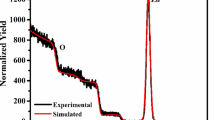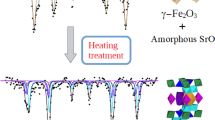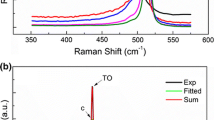Abstract
SrVO3 films have been deposited on quartz substrates using radiofrequency (RF) sputtering technique. Ag− ions have been implanted with three fluences: 1 × 1015 ions/cm2, 3 × 1015 ions/cm2, and 5 × 1015 ions/cm2. The glancing-angle x-ray diffraction (GIXRD) results exhibited a decrease in the peak intensity; however, the results ruled out the possibility of other secondary phase formation upon increasing the Ag− ion fluence. Field emission scanning electron microscopy (FESEM) results revealed that Ag implantation has sputtered the surface layer and created rough/emptied films. Significant broadening/splitting of V L2 near-edge x-ray absorption fine structure (NEXAFS) spectra convey the incorporation of Ag 4d states in the energy band structure of SrVO3 and electronic transitions from V 2p1/2 states to the Ag-related states. O K-edge spectra have ruled out the charge transfer of O 1s orbits to the Ag states, even upon increasing the Ag concentration, and nullified the formation of AgO types of secondary phases.
Similar content being viewed by others
Avoid common mistakes on your manuscript.
Introduction
ABO3 perovskite-type SrVO3 compound has been studied for its intriguing structural and electronic structure assets1,2,3,4 and various applications in perovskite solar cells, high-temperature solid oxide fuel cells, high-density dynamic random-access memory, etc.5,6,7,8 The cubic structured SrVO3 obeys 3d1 electronic configuration which provides an admixture of V 3d orbitals with O 2p orbitals. The non-bonding O 2p orbitals form the top of the valence band and the anti-bonding O 2p and V 3d orbitals constitute the bottom of the conduction band.1,2 It has been observed that polymorphous phases possess distortion in the V–O polyhedrons and provide diverse electronic properties to the compound.3,4 The native defects in SrVO3 and LaVO3 have evoked the origin of intriguing magnetic properties in the LaVO3/SrVO3 superlattice.9,10,11 Likewise, the electronic structure, charge carrier concentration/mobility, bandgap energy, and conductivity can be engineered by doping of the foreign elements at either V or Sr sites.12,13 However, the properties and, hence, applications of doped ABO3-type perovskites largely rely on the doping methods.14,15
In the context of foreign element doping, the ion implantation technique has several advantages like a high-purity process under high vacuum, depth control, concentration control, doping area control, etc.16,17,18,19,20 The factors that influence the properties of implanted materials are ion energy, ion fluence, and the nature of implanted ions. In this process, the implanted ions not only occupy the substitutional sites of host atoms but also create a large amount of point/cluster defects. Thus, control of these factors paves a way to manipulate the properties of materials systematically. There are only a few studies available for ion implantation-induced modification in SrVO3.21,22 Cu ion implantation in SrVO3 could facilitate lattice parameter changes and reduction in the bandgap energy via accumulating the Cu defect states.22 Analogous to the Cu atoms, the Ag atoms may facilitate the defect states of the SrVO3 compound. The partly occupied 4d orbitals of Ag (i.e., 4d9) are much more dispersive than that of 3d orbitals of Cu. Additionally, the Ag atoms are larger than the Cu atoms. Therefore, with Ag doping in SrVO3, one may expect larger V–O distortion and extended overlapping of Ag (4d) wavefunctions with the V (3d) wavefunctions when compared to the case of Cu doping in SrVO3. In this study, 90 keV Ag− ions were implanted in SrVO3 thin films. Three ion fluences were employed to investigate the extrinsic defect concentration dependency on the structural, surface morphology, and electronic structure assets of SrVO3 thin films.
Experimental Details
SrVO3 thin films were grown on quartz substrates by radiofrequency (RF) sputtering technique under the same experimental conditions as described elsewhere4 with the sputtering time of 60 min. The Ag− ions, with 90 keV of energy, were implanted in the prepared films with three different fluences of 1 × 1015 ions/cm2, 3 × 1015 ions/cm2, and 5 × 1015 ions/cm2 using a source of negative ions by cesium sputtering (SNICS) at IUAC, New Delhi, India. The vacuum of the implantation chamber was 5 × 10−7 torr. As-deposited and ion-implanted films were post-annealed at 6000C in air for 4 hrs. The glancing-angle x-ray diffraction (GIXRD) measurements were performed using the Rigaku D/Max 2500 x-ray diffractometer (Cu Kα radiation; λ = 1.5418 Å) with an incidence angle of 10 and a scan speed of 20 min−1. The lattice parameters and (hkl) values were evaluated using the JADE software package. Field emission scanning electron microscopy (FESEM) measurements were performed using a Hitachi (Regulus 8230) machine. Near-edge x-ray absorption fine structure (NEXAFS) measurements were collected, in total electron yield (TEY), at the V L edge and O K-edge, at the 10D XAS-KIST soft x-ray beamline at the Pohang Accelerator Laboratory (PAL), South Korea. In a typical NEXAFS measurement, the incident photon flux (Io) is measured by Au mesh placed in the path of the beam. Samples are mounted on a Cu holder with the help of carbon tape and placed in a high vacuum (5 × 10−8 torr). In the TEY method of data collection, all of the electrons (i.e., photoelectrons and Auger electrons) are collected with a Channeltron electron multiplier. In this mode of data collection, the low-energy electrons (<20 eV, with a large mean free path) are collected. TEY method is very effective for the topmost surface layers (i.e., for thin films). The energy resolution of the used beamline was better than 0.6 eV (at the O K-edge).
Results and Discussion
Stopping and range of ions in matter (SRIM; www.srim.org) calculations were performed to discern the cross over the ion range, straggling, electronic energy loss (Se) and nuclear energy loss (Sn) of Ag− ions in SrVO3 lattice. The range of Ag− ions in SrVO3 is 276 Å. The longitudinal and transversal straggling are 106 Å and 73 Å, respectively, as shown in supplementary Figure S1. It is clear from Figure S1 that Sn is greater than Se, and thus, various defects are expected to be formed due to Sn governing effects, such as point/cluster defect formation and surface sputtering. Supplementary Figure S2 shows the GIXRD data of as-deposited and as-implanted (ion fluence: 1 × 1015 ions/cm2, 3 × 1015 ions/cm2, and 5 × 1015 ions/cm2) SrVO3 thin films. It is noticeable that such a set of films do not show any intense diffraction peaks and reflect their poor crystalline or amorphous nature. The amorphous nature of as-deposited films may be due to the non-stoichiometric adsorption of constituent elements (Sr, V, and O) onto the quartz substrates. Moreover, the low-energy (90 keV) Ag− ions may have not supplied enough energy to grow the crystalline phases of SrVO3 compound. Therefore, the as-implanted samples are also amorphous.
Figure 1 shows the GIXRD patterns of pure and Ag− ion-implanted SrVO3 films annealed at 600°C. It is noticeable that several intense diffraction peaks are present in all of the samples and are strengthening the formation of polycrystalline films after the annealing with orthorhombic SrVO3 phase (a = 6.156 (12) Å, b = 7.701(15) Å, c = 5.367(07) Å, α = β= γ = 90°; the numbers in parentheses represent errors in the lattice parameters). The bottom panel of Fig. 1 shows the XRD profile from JCPDS file #06-9548. It is noticeable that major diffraction patterns of pure and Ag ion-implanted SrVO3 films closely match with the XRD patterns of the given JCPDS file and confirm the orthorhombic phase in the SrVO3 thin films. It is noticeable that the XRD peak intensity of the major peak [i.e., (200)] is diminished and that other low-intensity peaks [for example, (111)] are nearly vanished upon increasing the ion fluence of Ag ions. It could be due to the ion implantation-induced damage of SrVO3 lattice and various defect/stacking fault formations.19,22 Moreover, no AgO or other V oxide phases were detected under the detection limit of the used x-ray diffractometer.
GIXRD patterns of samples annealed at 600°C: pure SrVO3 (SrVO3_600), 1 × 1015 ions/cm2 implanted SrVO3 films (SrVO3_Ag1_600), 3 × 1015 ions/cm2 implanted SrVO3 films (SrVO3_Ag2_600), and 5 × 1015 ions/cm2 implanted SrVO3 films (SrVO3_Ag3_600). The bottom panel shows the XRD patterns from the JCPDS file #06-9548.
Surface morphology (2D view) was investigated using FESEM, and film thickness was estimated using the cross-sectional FESEM measurements. It is noticeable from Fig. 2a–b that pure SrVO3 (annealed at 600°C) film shows a packed and granular morphology with a film thickness of ~ 135 nm. The FESEM images of Ag− ions implanted (with ion fluence of 5 × 1015 ion/cm2 and annealed at 600°C) sample is showing a rough morphology with some voids, and the film thickness is ~ 95 nm. The induced roughness and reduction in film thickness may be due to the Ag− ion-induced surface sputtering of SrVO3 thin film and is analogous to the previous reports.19,22 The EDS results of the Ag− ion-implanted (5 × 1015 ion/cm2) sample are presented in supplementary Figure S3 which conveys the even distribution of elements in the film. The atm% of elements is also provided in supplementary Table 1.
Figure 3 shows NEXAFS spectra of pure and Ag− ion-implanted SrVO3 thin films (annealed at 600°C). The spectral features between 515 eV and 528 eV are of the V L-edge and correspond to the V 2p to V 3d electronic transitions.23,24,25 There are two distinct peaks in the V L-edge spectrum of pure SrVO3 film, marked by L3 and L2. These peaks originate from V 2p3/2 and V 2p1/2 core level transitions to the unoccupied V 3d levels, respectively. The pre-edge features of the V L-edge (not allowed by selection rules) may appear due to crystal field effects of various V-related defects (i.e., interstitials/stacking faults) in thin films.4 It is noticeable that the V L2-edge feature shows broadening/splitting (towards higher energy) upon increasing the Ag− ion fluence and signifies that Ag implantation has created various defects in the film. The Ag-related defects may have imposed 4d states which are overlapping with the V 3d levels. There are significant electronic transitions above the V L2 level which give broadening in the V L2-edge (see the inset of Fig. 3). Our XRD results have also demonstrated the distortion in the crystallinity of SrVO3 films upon Ag implantation. Therefore, changes in the V L-edge NEXAFS are analogous to the changes in the crystalline properties of SrVO3 films.
V L-edge and O K-edge NEXAFS spectra of samples annealed at 600°C: pure SrVO3 (SrVO3_600), 1 × 1015 ions/cm2 implanted SrVO3 films (SrVO3_Ag1_600), 3 × 1015 ions/cm2 implanted SrVO3 films (SrVO3_Ag2_600), and 5 × 1015 ions/cm2 implanted SrVO3 films (SrVO3_Ag3_600). The inset shows a magnified view of the V L-edge.
The high-energy spectral feature in Fig. 3 (between 528 eV and 540 eV) are due to O K-edge transitions. The O K-edge spectrum originates from O 1s transitions to the O 2p states which hybridized with the metal d states. The O1 peak represents the O 1s electronic transitions to the O 2p hybridized with metal 3d (i.e., t2g orbital; a group of dxy, dxz, and dyz orbitals). Similarly, the O2 peak is due to the O 1s electronic transitions to the O 2p hybridized with metal 3d (i.e., eg orbitals; group of dx2–y2 and dz2 orbitals).4,22 It is noticeable that there are no significant changes in the O K-edge spectra of Ag-implanted SrVO3 films. This signifies that Ag atoms are not directly interacting with the O atoms or not making Ag oxides in the SrVO3 films (as supported by XRD studies). This helps us to conclude that Ag implantation in SrVO3 films modifies the electronic structure properties in the higher-energy states to the V 3d density of states and that there is no or unnoticeable charge transfer from O atoms to the Ag atoms.
Conclusions
RF sputtering-grown SrVO3 films were implanted with 90 keV Ag− ions with three different fluences. GIXRD results confirm the Ag implantation induced defect formation in the films and resulted in the diminished XRD peak intensity. The FESEM results convey the rough/pore surface and surface erosion after Ag ion implantation. V L-edge NEXAFS spectra have shown modification in the electronic structure properties of SrVO3 thin films which are reflected as higher-energy broadening/splitting of the V L2-edge peak. Ag 4d levels participated in the V 2p1/2 electronic transitions to V 3d in the Ag-implanted SrVO3 films. The O K-edge spectra are invariant under the Ag implantation-induced modification of the density of states and signify that O atoms are not sharing charges with Ag atoms.
References
K. Yoshimatsu, K. Horiba, H. Kumigashira, T. Yoshida, A. Fujimori, and M. Oshima, Science 333, 319 (2011).
L. Zhang, Y. Zhou, L. Guo, W. Zhao, A. Barnes, H.T. Zhang, C. Eaton, Y. Zheng, M. Brahlek, H.F. Haneef, N.J. Podraza, M.H.W. Chan, V. Gopalan, K.M. Rabe, and R.E. Herbert, Nat. Mater. 15, 204 (2016).
M. Wu, J.-C. Zheng, and H.-Q. Wang, Phys. Rev. B. 97, 245138 (2018).
A. Sharma, M. Varshney, W.C. Lim, H.J. Shin, J.P. Singh, S.O. Won, and K.H. Chae, Phys. Chem. Chem. Phys. 19, 6397 (2017).
Z.B. Yan, and J.-M. Liu, Sci. Rep. 3, 2482 (2013).
M. Liu, S.P. Ren, R.Y. Zhang, Z.Y. Xue, C.R. Ma, M.L. Yin, X. Xu, S.Y. Bao, and C.L. Chen, Sci. Rep. 5, 10784 (2015).
J. Varignon, N.C. Bristowe, E. Bousquet, and P. Ghosez, Sci. Rep. 5, 15364 (2015).
L. Fagiolari, and F. Bella, Energy Environ. Sci. 12, 3437 (2019).
U. Lüders, W.C. Sheets, A. David, W. Prellier, and R. Frésard, Phys. Rev. B 80, 241102(R) (2009).
P. Boullay, A. David, W.C. Sheets, U. Luders, W. Prellier, H. Tan, J. Verbeeck, G. Van Tendeloo, C. Gatel, G. Vincze, and Z. Radi, Phys. Rev. B. 83, 125403 (2011).
S.Y. Park, A. Kumar, and K.M. Rabe, Phys. Rev. Lett. 118, 087602 (2017).
D. Srivastava, C. Norman, F. Azough, M.C. Schafer, E. Guilmeau, and R. Freer, J. Alloys Compd. 731, 723 (2018).
S. Miyasaka, Y. Okimoto, M. Iwama, and Y. Tokura, Phys. Rev. B 68, 100406R (2003).
C.S. Park, M.H. Hong, H.H. Cho, and H.H. Park, J. Eur. Ceram. Soc. 38, 125 (2018).
L. Wang, Y. Li, A. Bera, C. Ma, F. Jin, K. Yuan, W. Yin, A. David, W. Chen, W. Wu, W. Prellier, S. Wei, and T. Wu, Phys. Rev. Appl. 3, 064015 (2015).
D. Ksh, A. Devi, S. Sharma, J. Ojha, A. Parkash, R.K. Vij, and F. Sharma, Singh. Mat. Lett. 308, 131283 (2022).
A. Sharma, M. Varshney, H.J. Shin, and K.D. Verma, J. Phys. Chem. Sol. 75, 1024 (2014).
J. Seo, S. Hajra, M. Sahu, and H.J. Kim, Mat. Lett. 304, 130674 (2021).
S. Chaudhary, H. Saraswat, D. Devi, P. Kulriya, F. Singh, S.O. Won, H.J. Shin, J. Parkash, and A. Sharma, Vacuum 179, 109481 (2020).
M. Sahu, S. Safranko, S. Hajra, A.M. Padhan, P. Zivkovi, S. Jokic, and H.J. Kim, Mat. Lett. 301, 130290 (2021).
C. Wang, H. Zhang, K. Deepak, C. Chen, A. Fouchet, J. Duan, D. Hilliard, U. Kentsch, D. Chen, M. Zeng, X. Gao, Y.J. Zeng, M. Helm, W. Prellier, and S. Zhou, Phys. Rev. Materials 3, 115001 (2019).
H. Saraswat, S. Chaudhary, M. Varshney, D. Devi, F. Singh, S.O. Won, H.J. Shin, and A. Sharma, Vacuum 181, 109655 (2020).
Y.R. Lu, H.H. Hsu, J.L. Chen, H.W. Chang, C.L. Chen, W.C. Choud, and C.L. Dong, Phys. Chem. Chem. Phys. 18, 5203 (2016).
A. Sharma, M. Varshney, K.H. Chae, and S.O. Won, RSC Adv. 8, 26423 (2018).
C. Zou, L. Fan, R. Chen, X. Yan, W. Yan, G. Pan, Z. Wu, and W. Gao, CrystEngComm 14, 626 (2012).
Acknowledgments
Aditya Sharma is thankful to IUAC, New Delhi, India, for providing 90 keV Ag− ion beam from the low-energy ion beam facility (LIEBF) under the BTR proposal scheme (number 65520). Hyun-Joon Shin would like to acknowledge the support from the National Research Foundation of Korea (NRF- 2015R1A5A1009962).
Author information
Authors and Affiliations
Corresponding authors
Ethics declarations
The authors declare that they have no conflict of interest.
Additional information
Publisher's Note
Springer Nature remains neutral with regard to jurisdictional claims in published maps and institutional affiliations.
Supplementary Information
Below is the link to the electronic supplementary material.
Rights and permissions
About this article
Cite this article
Sharma, A., Devi, K.D., Varshney, M. et al. Structural, Surface, and Electronic Structure Properties of Ag− Ion-Implanted SrVO3 Thin Films. J. Electron. Mater. 51, 1900–1904 (2022). https://doi.org/10.1007/s11664-022-09454-5
Received:
Accepted:
Published:
Issue Date:
DOI: https://doi.org/10.1007/s11664-022-09454-5







